by Steve Selden | Jul 21, 2015 | Conservation

Polar bear on sea ice in the Arctic. Nasa photo.
The Arctic summer of 2013 was a cool one. So much so that the trend of decreasing sea ice has regained it’s recent losses by at least one third over the last few years. Because of the cool summer that year, more multi – year ice was left at the end of the summer.
Despite the encouraging news, scientists cautiously warn the news is an anomaly and climate change related to warming is still very real.
“It would suggest that sea is more resilient perhaps if you get one year of cooler temperature. We’ve almost wound the clock back a few years on this gradual decline that’s been happening over decades,” lead author Rachel Tilling told BBC News. “The long-term trend of the ice volume is downwards and the long-term trend of the temperatures in the Arctic is upwards and this finding doesn’t give us any reason to disbelieve that. As far as we can tell, it’s just one anomalous year.”
President Obama will visit Anchorage, Alaska on August 31 to address the state departments GLACIER conference. Foreign ministers from Arctic nations as well as non – Arctic states will attend as well as scientists, policy makers and stakeholders from the Arctic and Alaska will also attend.
The conference goal is to increase global awareness of how Arctic climate change is a harbinger for warming affects in the rest of the world.
by Steve Selden | Jul 20, 2015 | Churchill Photography
Churchill’s summer wildflowers are in full bloom igniting the tundra with a patchwork of life exuding color. The Arctic wildflowers are incredible and throughout the summer different waves of color emerge. As a guide for the Arctic summer trips, I became immersed in identifying the flowers and educating travelers on the unique qualities of each. The tundra and its colors are one aspect of the amazing Churchill Arctic summer!

Round-leaved orchid, purple paintbrush and bog asphodel. Rhonda Reid photo.
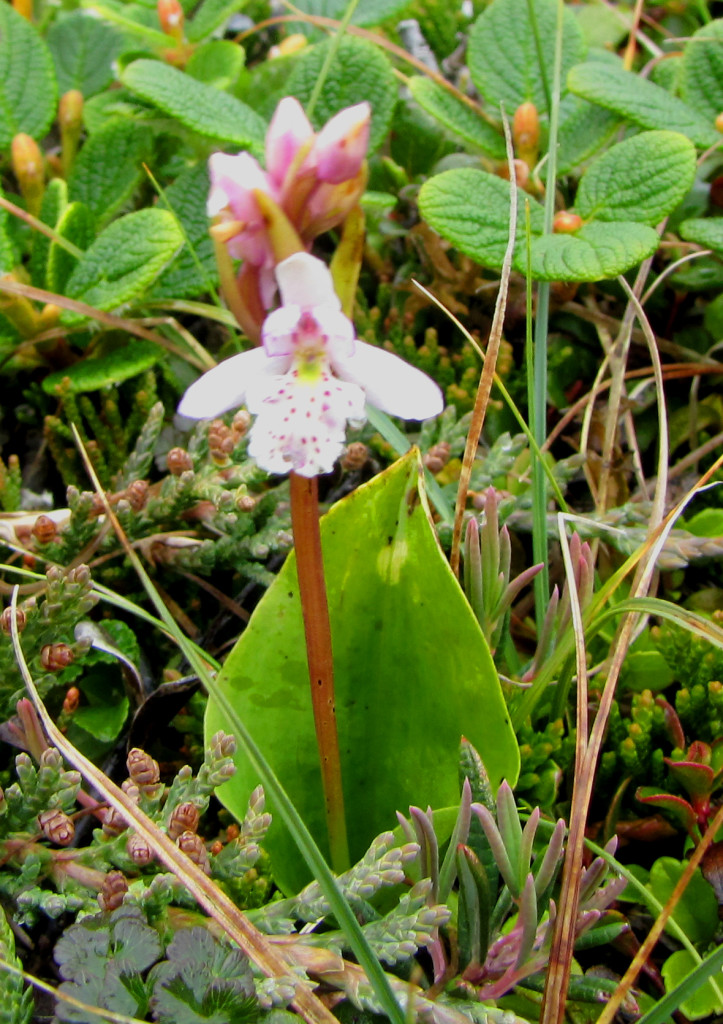
Round – leaved orchid in Churchill. Steve Selden photo.

Churchill wildflowers on the tundra. Steve Selden Photo.

August colors of the tundra. Ed Bouvier photo.
by Steve Selden | Jul 8, 2015 | Conservation
Our northern ecosystems are changing and this time sea ice is not the suspect. International scientists headed up by the University of Edinburgh have results from a comprehensive study on vegetation comprising the Arctic tundra. Research was conducted on 37 sites in nine countries, monitoring shrub growth in the Arctic spanning 60 years. Curiously plant growth is not a good thing.
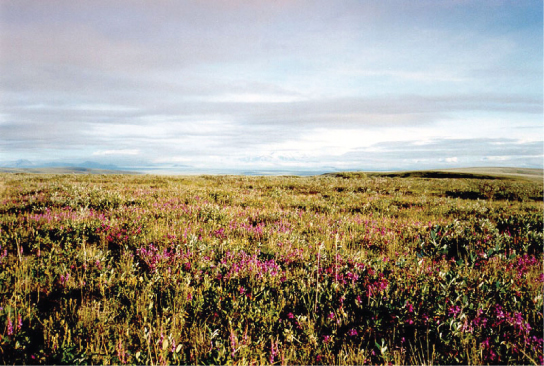
Arctic shrubs moving further north. Boundless.com photo.
Arctic shrubs, in most cases willows, are growing and moving north at fairly rapid rates. These tundra shrubs act as a barometer of the Arctic and their increased presence is “strong evidence” that climate change is happening. Focus on diminishing sea ice has been the headline for years and this is just auxiliary evidence that global warming is real.
The growth and spreading of these shrubs in itself is not the problem. What occurs and perpetuates increases in temperatures is the way these thicker stands of plant life fuel warming. Taller, thicker growth of shrubs prevents snow from reflecting sun back away from our planet, therefore warming the Earth’s surface. This process leads to soil temperature increase and thawing of permafrost.
Increased shrub stands change nutrient cycling and carbon levels in the soil and thus affect the decomposition rate and then the amount of carbon released into the atmosphere from thawing permafrost. Dr. Isla Myers-Smith was the study co-ordinator for this project and she cautioned on the increased shrub growth; “Arctic shrub growth in the tundra is one of the most significant examples on Earth of the effect that climate change is having on ecosystems.” ( Reported by Press Association July 6, 2015)
The research is documented comprehensively in Nature Climate Change and funded by the International Arctic Science Committee.
by Steve Selden | Jul 7, 2015 | Churchill News
Yesterday, in Churchill, Shelly Glover, Minister of Canadian Heritage and Official Languages and Minister responsible for Manitoba, along with Manitoba Premier Greg Selinger announced the future construction of $31.7 million marine research facility, the Churchill Marine Observatory, in Churchill. The facility will be located adjacent to the Port of Churchill which is Canada’s sole Arctic accessible deep-water port.

Officials in Churchill announcing plans for Churchill Marine Observatory. Town of Churchill photo.
Apparently the main focus of the Churchill Marine Observatory will be a facility for researchers to study discovery, impact and mitigation of oil spill disasters in sea ice regions within the northern Arctic and subarctic regions. The observatory will also study issues encompassing present and future Arctic marine transportation. Climate change and sea ice shifting has created new possibilities for shipping in the northern regions. Canada and specifically Churchill will be strategically positioned globally through ongoing study of the scientific and economic issues that pertain to Arctic marine transportation with regards to oil and gas exploration.
Researchers from major Canadian universities, University of Washington and Canadian federal government departments will come together through this new facility. Saltwater subpools and an environmental observing system constructed on the Churchill estuary will allow scientists to study actual conditions and complications of oil spills in Arctic seawater and sea ice. Overall, hopes the project will strengthen Canada’s capacity to protect the environment in the Arctic.
by Steve Selden | Jul 6, 2015 | Churchill Photography
An overcast day in Churchill provided the perfect setting for some beautiful photographs of the natural surroundings of the region. Birds are nesting and the wildflowers are blooming all over the tundra. Beluga whales are arriving in the Churchill River in pods and we will be posting photos soon from some Natural Habitat Adventures trips in July. Enjoy these Awesome photos!
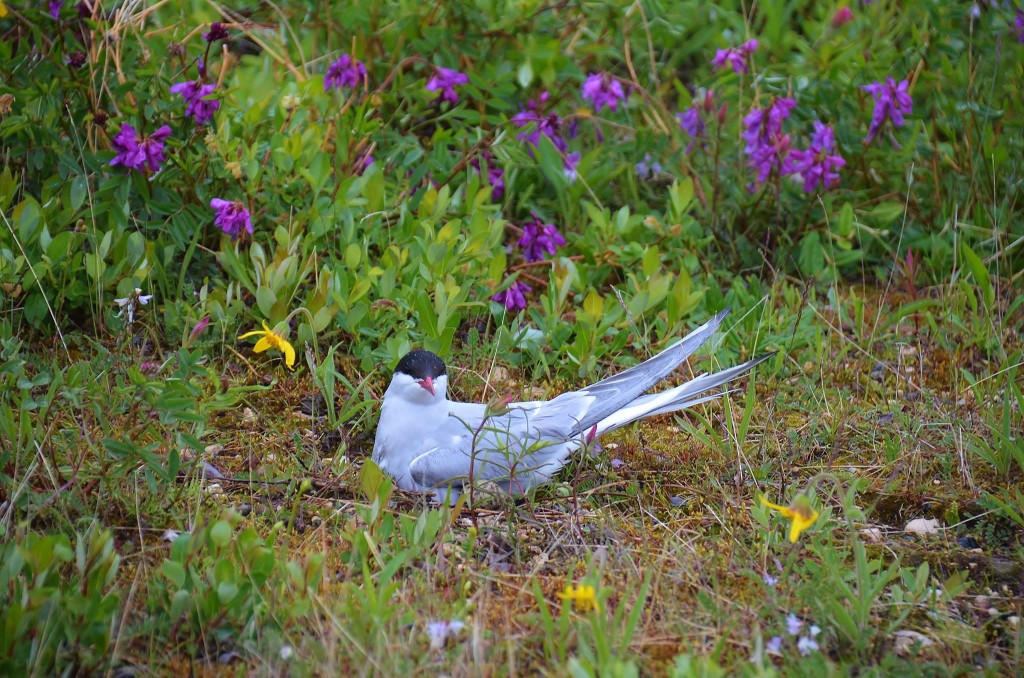
Arctic tern in a nesting area. Rhonda Reid photo.

This exquisite close – up image of an Arctic Tern incubating eggs on its nest shows just how camouflaged their eggs are. It took me awhile to even see the one egg in front of the tern since it blends so well into the tundra. Arctic terns lay 1 – 3 eggs and both the male and female incubate the eggs for up to 22 days. After birth the parents supply small fish up until they fledge at three to four weeks old. Female and male Arctic terns mate for at least a year and can mate for life. Females lay eggs once a year. Terns live on average up to 34 years.
The photo of the three Arctic tern eggs illustrates the magnificent camouflage adaptation the eggs have developed over many years. The way animals and their eggs adapt to the environment using camouflage is fascinating. Survival of species depends on these slight changes over periods of time. The faster a species can adapt the longer they can survive in nature.

The Precambrian shield rolls down to the Hudson Bay in Churchill. Rhonda Reid photo.
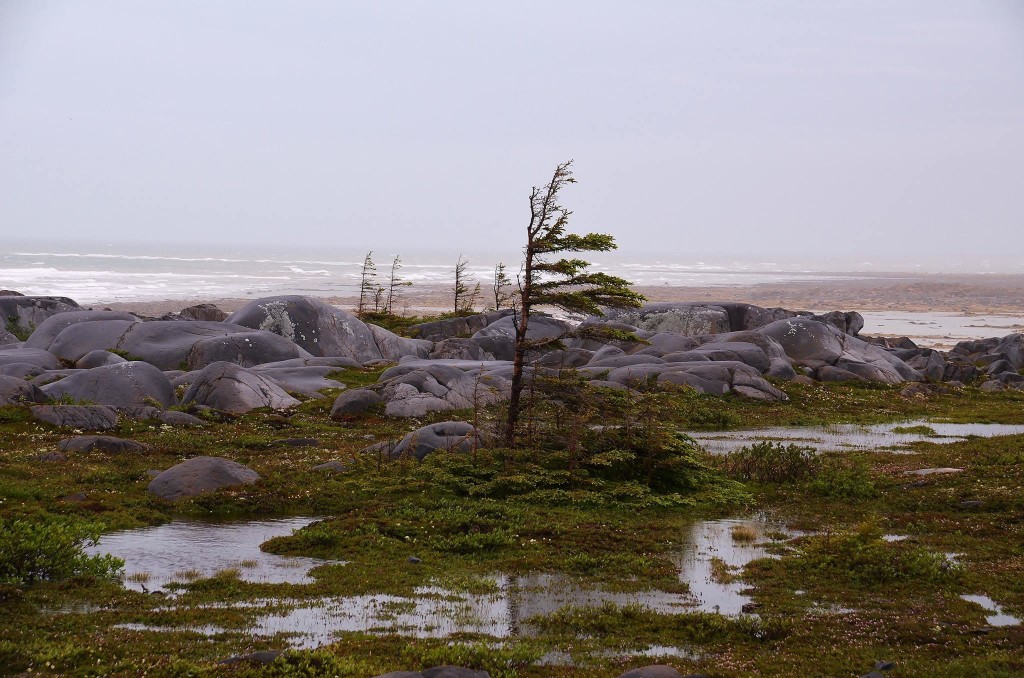
Precambrian shield with a bog and krumholz spruce. Rhonda Reid photo.
These two photos of Precambrian shield rolling toward the Hudson Bay show how the rocks have been smoothed over in previous eras by ice and water covering them. If you look closely you can see marks or “striations” caused from rocks embedded in the bottom of glaciers that were dragged over them during the slow movements of the massive ice formations. It’s quite interesting to search out these striations while hiking over the shield in Churchill.
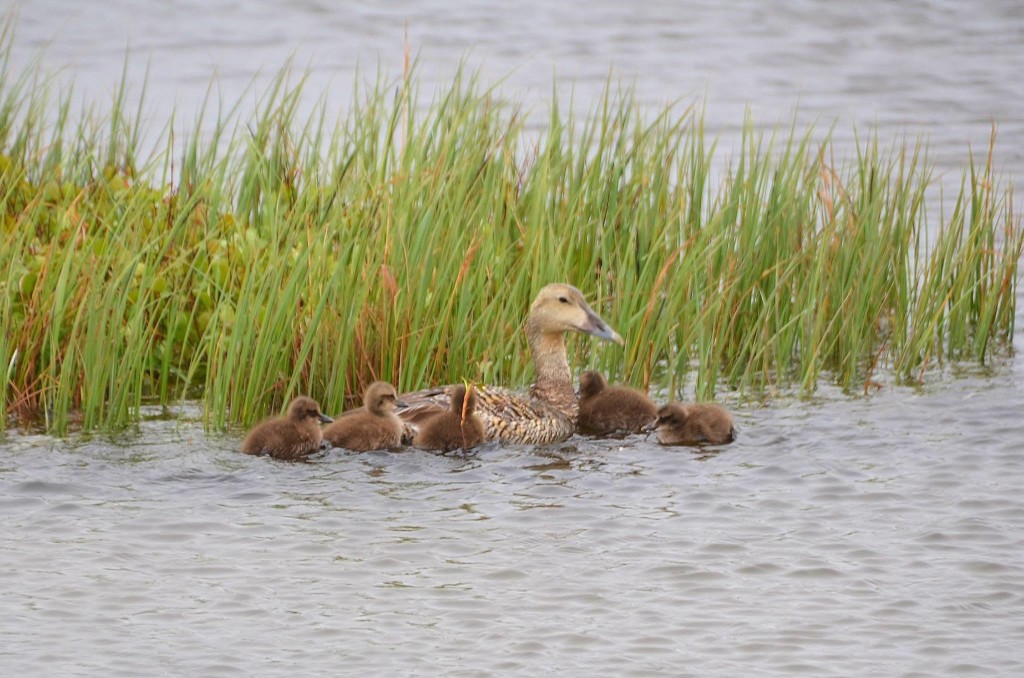
Eider duck female and her brood of five chicks. Rhonda Reid photo.












